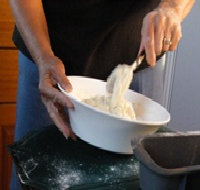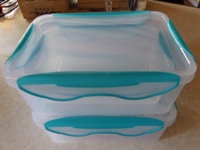Australia So Much to See


Food and cooking tips
Canned products take up more room and can be quite heavy, so if this is a problem and water supply is not, consider carrying more
dried foods than canned.
UHT milk
Powdered milk
Canned vegetables
Dried vegetables
Canned fruit
Dried fruit
Make
your own fresh bread, rolls or damper
Crispbread, rice or corn thins or cracker biscuits
Sealed packets of wraps or mountain
bread
Canned fish, canned meats
Hikers dried meat products and meals
Non refrigerated cheese such as Kraft (will not keep
indefinitely after opening)
Canned baked beans, chick peas or beans
Dried beans, chick peas and lentils, however most of these require longer cooking time which may not be practical if driving each day unless you use a thermal cooker such as Dream Pot.
Canned soup
Instant packet soup
Rice
Pasta
Pasta and sauce 10 minute packets, 2 minute noodles
Rice 10 minute packets
Margarine
will keep longer unrefrigerated than butter, and can be kept in an esky
Jams and spreads do not require refrigeration
An esky
left outside and open during the cool of the night will keep drinks and salad vegetables in a satisfactory state. Eggs
will last for some days kept cool in the esky.
So with all that, who needs a fridge?
See what to take and cook when
you go camping without a fridge here
If freezer space is limited, avoid bulky meats such as steak and chops. Choose from mince, chicken fillets, fish fillets and
sausages. I keep a packet of puff pastry in the freezer as this takes very little room and is easy to use for pies and nicer
than bread for jaffles. A few slices of bacon, in individual freezer bags for easy use, also takes up very little space.
I pack mince into meal sized cubes so there is very little waste space.
Bulkier meats such as chops are eaten soon
after purchase without the need to freeze.
With dried peas and corn, the only frozen vegetables I carry are frozen cauliflower and broccoli. These are often used to make cauliflower cheese as a meatless meal.
Choose spray can of cooking oil rather than a bottle which will make a very sticky mess if the lid comes loose.
Powdered cordial
instead of liquid cordial. The latter can manage to escape through the lid of an unopened bottle and the sticky mess takes a
lot of washing to get rid of.
I have had bottles of soft drink leak in transit, and the lid come off a bottle of
soy sauce. Any liquid products should be treated with caution and only taken when necessary if travelling long distances on
bumpy or corrugated roads. If necessary, you can tape the lids down for rough road travel. Cans of drinks seem to
last the distance satisfactorily.
UHT milk cartons can leak if they are not packed tightly enough to remain upright. Ideally, purchase by the carton and leave them in the carton until needed, placing a substitute when one is removed to keep them tightly
packed and upright. I have used an upturned soft drink bottle when I have not had anything the right size. However a place
to store the carton needs to be available.
After a day of driving on a corrugated road, in addition to checking anything
that can come loose in your rig, check the lids on bottles and jars as these too can come unscrewed.
Most vegetables will keep better wrapped in brown paper than in plastic bags. Save mushroom bags for smaller items.
Choose
Cos lettuce over Iceberg lettuce for a much longer shelf life
Roma tomatoes last much longer than other standard varieties of
tomatoes
Sweet potatoes have a longer shelf life than potatoes and pumpkin
Cabbage and carrots both last well when travelling
Sitting on the dashboard of a closed car, so long as there is some sun, is the best place to raise dough. A thermal pot such as Dream
Pot could be used to keep the dough warm.
When risen, flatten the dough and remove any large bubbles. Divide
into eight pieces if making rolls, and flatten each and roll and flatten several times in the palm of your hand or on a floured tray. Shape into a roll and place on a silicon baking sheet on a tray for easy movement. This makes lunch for a family of four
or two days for two people.
Cover with a tea towel then place on the dashboard of your closed car and leave to rise for another hour. This will give a crispy crust. If you prefer a soft crust, cover with Glad Wrap or other food grade plastic during the rising stage. A light spray of oil across the top of the rolls will prevent the plastic wrap from sticking to the dough.
Alternatively flatten the dough on a floured tray and roll and flatten several times before shaping into a loaf. Place in silicone loaf pan, cover and place on dashboard to rise.
Cook rolls for around 20 to 25 minutes in a 180 degrees C oven and bread for 35 to 40 minutes. A hotter oven will crisp the crusts better, whereas slower cooking will retain a soft crust.
I have not found keeping the dough in the car while travelling very satisfactory, however if you need to travel early it would be possible to form the rolls before you leave, and keep them in the car until you stop for lunch. A short wait while they cook and you can have delicious hot fresh bread rolls for lunch.
Alternatively, as dough keeps well in the fridge and takes up little space, this can be mixed and partly raised then packed into a plastic bag or container for refrigeration. When stopping, the dough can be shaped into rolls or bread loaf, warmed and raised in the warmth of the car for about an hour, then cooked.
For variations to rolls or bread:
Herb and cheese: Add a pinch of mixed herbs, or if preferred a little steak spice or pepper, together with a small quantity of grated tasty cheese mixed into the flour. Too much cheese makes the dough sticky.
Sweet potato bread: Add cool mashed sweet potato with the flour; half a medium sweet potato is plenty. This will either make a larger quantity, or reduce flour and water to compensate.
Sweet buns: Add quarter of a teasoon of mixed spice and about half that of cinnamon together with two teaspoons of sugar when mixing. When forming the rolls or loaf, fold in a handful or two of sultanas, dried mixed fruit or raisins. When adding sugar, bread tends to stick to a bread pan so better for making rolls or a plait loaf.
If travelling every day, purchasing bread may be easier than making it, but if you require gluten free purchasing may not always be an option, so making your own is necessary. Gluten free ingredients are available at major supermarkets and health foods shops, and the internet is a source of a variety of gluten free bread recipes.
I have found making a small quantity, without using traditional heel-of-hand kneading method, easy to do in the caravan and it works
well.
Bread Mix Flour 285 gms (2 cups)
Water 165 mls
Yeast 3.5 gms (1 sml scoop)
Water can be slightly warm and for a quicker start to the rising, dissolve the yeast powder in the lukewarm water. Mix ingredients thoroughly together in a bowl to a thick paste, cover with a tea towel and place in a warm spot for one hour.
As an alternative, a search of the internet will find a number of no knead bread making options.
We love yoghurt and make it regularly in an electric yoghurt maker when at home and we prefer this to most commercial yoghurt brands. Although the draw on the inverter would probably be minimal, I have not taken my yoghurt maker with us. I have still
made yoghurt while travelling.
My recipe:
To make one litre of thick and creamy yoghurt
In a one litre
yoghurt container or jar half fill with lukewarm water
Add four to five heaped dessertspoons of low fat milk powder (80 to 100
grams)
Add the same of full cream milk powder
Add a heaped dessertspoon or two of fresh unflavoured yoghurt (commercial yoghurt cultures
can also be used).
Mix well with spoon or whisk
Top up with warm water
Cover and keep in a warm place for six to seven hours
On
hot days I left the container out on the caravan bench while out touring or walking for the day and achieved a good result.
On not so hot days I found a warm spot; in our case next to the fridge compressor, packed with foam rubber around it as insulation.
It was not satisfactory on cool days, nor when moving as the movement seemed to keep the yoghurt thin.
A thermal
pot such as Dream Pot could be used to keep the yoghurt warm.
Theoretically you can use some of your remaining yoghurt
to start the next batch, but this is not always as successful as using fresh each time.
If you like to add fruit,
do so when serving as the fruit acids can kill the beneficial bacteria in the yoghurt.
Hints on foods that travel well, those that donít require refrigeration and how to make bread and rolls easily while on the road.
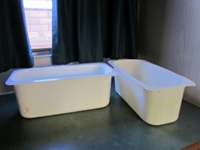
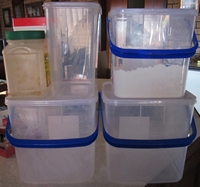
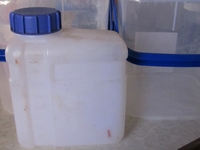
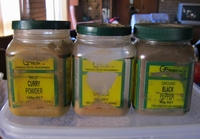
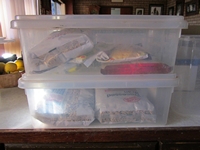
Purchase rolls of non skid matting from Cheap shops to line the shelves.
Use plastic mesh tray to hold pantry items. Do not use cardboard boxes that have contained food products (be they fruit, vegetables, eggs or honey). These may not be able to pass through state borders or quarantine point checks. See Quarantine and Exclusion zones.
If you can get the large oblong icecream containers as used by caterers, these are ideal to store food in the fridge and in the larder, particularly products that may spill or leak.
Choose square or rectangular containers in preference to round eg square plastic jars of fruit rather than round cans; square plastic spice jars rather than round. These pack in easier being square, and stay put in the cupboards on rough roads. I save a few of square plastic jars for putting any canned fruit I may purchase in after opening to store in the fridge. Glass is heavy so where possible decant into plastic jars. There is also a chance of breakages with glass.
